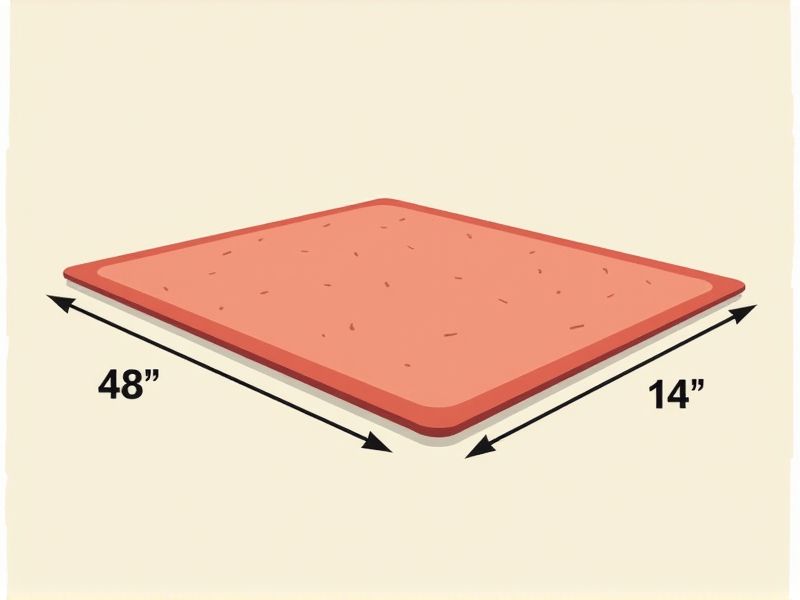
Carpet typically comes in standard widths to make installation more convenient and reduce the number of seams. In most regions, the standard width of broadloom carpet is 12 feet (3.66 meters), though some options are available in 15 feet or even 13 feet widths for larger spaces. Carpet tiles, another popular choice, often come in 18-inch by 18-inch or 24-inch by 24-inch square sizes, making them flexible for unique room layouts. Knowing these dimensions helps you plan your room design and minimize material waste during installation.
Width
The standard width for carpets typically ranges from 12 to 15 feet, accommodating various room sizes and layouts. A 12-foot width is most common and ideal for larger spaces, while 15-foot options are beneficial for expansive areas, reducing the need for seams. Carpet rolls are often sold in 6-foot widths as well, which provide flexibility for smaller rooms or custom installations. Choosing the right width enhances both the aesthetic appeal and functionality of your flooring.
Length
When choosing a carpet, pay close attention to its length, which typically ranges from 1 to 12 feet wide. Standard lengths usually vary based on material, with wool and nylon often available in rolls that extend up to 100 feet. A precise measurement is crucial to ensure a proper fit for your space, as an ill-fitting carpet can lead to excess waste or the need for costly modifications. You can visualize how a specific length will impact your room's aesthetics by using carpet samples to assess different options before making a purchase.
Thickness
The standard thickness of residential carpets typically ranges from 0.5 inches to 0.75 inches, providing a plush feel underfoot while maintaining durability. Commercial carpets, on the other hand, tend to be thinner, often measuring around 0.25 inches to 0.5 inches, designed to withstand high foot traffic. Choosing the right thickness affects insulation, comfort, and noise reduction, with thicker carpets generally offering better sound absorption and warmth. Consider your specific needs, as thicker carpets can also be more challenging to clean and maintain.
Roll Size
Carpet rolls typically come in standard sizes, with 12 feet being the most common width for residential applications. The length of these rolls can vary significantly, often ranging from 15 to 30 feet or more, allowing for flexibility in covering large areas without seams. When selecting carpet, consider that larger roll sizes reduce waste and installation complexity, resulting in a more cost-effective solution. For your project, understanding the roll size can streamline your buying process and enhance the overall appearance of your space.
Weight Per Area
The standard for carpet weight is typically measured in ounces per square yard, with a common range falling between 32 to 80 ounces. A heavier carpet, generally over 50 ounces, often indicates a denser construction, leading to increased durability and comfort. When selecting a carpet, consider that a higher weight can also provide better sound insulation and insulation against temperature fluctuations. For optimal performance, you should aim for a balance between weight and fiber type to match the specific needs of your space.
Fiber Density
Fiber density in carpets is a critical factor that determines durability and comfort, typically measured in ounces per square yard. High fiber density carpets, ranging from 40 to 80 ounces, provide increased resistance to wear and a plush feel underfoot. For residential spaces, a density of at least 32 ounces is recommended to enhance longevity and performance. Your choice of carpet with optimal fiber density can significantly impact the aesthetic quality and maintenance of your living environment.
Pile Height
Pile height is a crucial metric in assessing carpet quality, typically ranging from 1/4 inch to over 1 inch. Carpets with a low pile height of 1/4 to 1/2 inch are ideal for high-traffic areas, offering durability and easy maintenance. Medium pile carpets, around 1/2 to 3/4 inch, provide a balance between comfort and resilience, perfect for living rooms and bedrooms. Plush carpets often exceed 3/4 inch, delivering a luxurious feel but may require more care and should be used in lower-traffic zones to maintain their appearance.
Backing Type
Carpet backing plays a crucial role in determining the durability and performance of flooring solutions. Options for backing types include action bac, felt, and woven, each offering unique benefits such as enhanced stability and moisture resistance. For example, action bac is commonly used in commercial settings due to its strength and ease of installation, while felt backing provides sound insulation and comfort, making it suitable for residential environments. Selecting the right backing type can significantly impact your carpet's lifespan, maintenance needs, and overall aesthetic appeal.
Tufting Gauge
The Tufting Gauge, typically measured in inches, is a critical standard in the carpet industry that signifies the density of yarn loops per unit of tufted carpet. A higher Tufting Gauge, such as 7/32", indicates a denser carpet, providing enhanced durability and comfort underfoot, while a lower gauge, like 1/8", results in a looser pile, which may be more suitable for low-traffic areas. Understanding the Tufting Gauge helps you select the right carpet for your specific needs, balancing aesthetics and functionality. For example, residential carpets often range from 1/8" to 3/8" gauge, reflecting varied priorities such as softness and resilience.
Repeat Pattern Size
When selecting carpets, the repeat pattern size significantly affects the overall aesthetic and design coherence of your space. A smaller repeat pattern, typically measuring 12 to 24 inches, can create a more intricate and detailed look, perfect for smaller rooms or cozy settings. In contrast, larger repeat sizes, often exceeding 24 inches, are ideal for spacious areas, making a bold statement while maintaining visual harmony. Understanding these measurements helps you choose a carpet that enhances your interior design and fosters a pleasing atmosphere.
